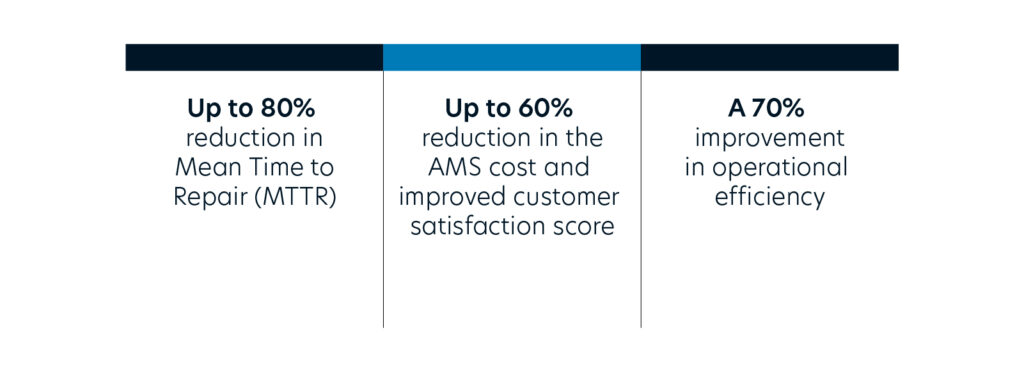The Strategic Playbook for AIOps Triumph in IT Operations

Introduction
In the realm of Information Technology (IT), the seismic shift towards digital transformation has ushered in a new era of complexity and challenges that traditional IT operations struggle to navigate effectively.
Ranging from siloed data sources and fragmented toolsets to the overwhelming volume of alerts and incidents on a daily basis, the challenges facing modern IT environments are multifaceted and dynamic. According to Forrester, businesses spend nearly 80% of their IT budgets on maintaining existing systems and infrastructure, leaving limited room for innovation.
As organizations grapple with escalating data volumes, diverse technology stacks, and increasing user demands, the need for transformative solutions has never been more critical. This where the convergence of Artificial Intelligence (AI) and IT Operations as coined by Gartner – AIOps – stands at the forefront of IT innovation, poised to reshape the future of digital operations and revolutionize how businesses manage and optimize their IT environments.

With this ebook, we aim to take a closer look at how AIOps offers true value in enhancing your IT operations. This insightful paper explores in-depth how AIOps overcomes the limitations of traditional IT management, offering a comprehensive analysis of its key components, benefits, and implementation strategies. By understanding the transformative potential of AIOps, organizations can position themselves at the forefront of innovation, driving efficiency, agility, and resilience in the digital age.
Why AIOps is Important?
Artificial Intelligence for IT Operations (AIOps) is a transformative approach to managing and optimizing IT infrastructure and services using artificial intelligence (AI) and machine learning (ML) techniques. AIOps integrates advanced analytics, automation, and orchestration to enhance the efficiency, reliability, and scalability of IT operations, addressing the complexities and challenges of modern IT environments.

One of the key pillars of AIOps is its proactive approach to IT management. By leveraging AI-powered anomaly detection and predictive analytics, organizations can anticipate potential issues before they escalate, enabling them to take preemptive actions and prevent costly downtimes. This shift from reactive to proactive IT operations not only enhances system reliability but also allows IT teams to focus on strategic initiatives that drive business growth.
Harnessing Advanced Technologies for AIOps Success: A Comprehensive Overview
AIOps represents a pivotal shift in IT operations management, leveraging cutting-edge technologies to drive innovation, optimize resource utilization, and deliver superior user experiences. By harnessing the power of AI and advanced analytics, organizations can unlock new levels of operational efficiency and responsiveness in today’s fast-paced digital landscape.
Let us have a look at the technologies that helps transform traditional IT operations into proactive, automated, and intelligent processes.
1. Machine Learning (ML)
Machine learning forms the backbone of AIOps, enabling systems to analyze vast amounts of data and identify patterns, anomalies, and trends in real-time. ML algorithms can detect deviations from normal operational behavior, predict potential issues before they occur, and recommend optimal solutions. According to Forrester, ML-driven AIOps solutions can reduce incident volumes by up to 70% through early detection and automated remediation.
2. Big Data Analytics
AIOps relies on big data analytics to process and analyze large volumes of structured and unstructured data from diverse sources such as logs, metrics, events, and traces. This enables IT teams to gain holistic insights into system performance, user behavior, and operational efficiency.
3. Event Correlation and Root Cause Analysis
Event correlation techniques in AIOps help connect disparate data points to pinpoint the root cause of incidents or performance issues. Advanced correlation engines use probabilistic reasoning and dependency mapping to identify causal relationships across complex IT environments. McKinsey notes that effective event correlation can reduce mean time to resolution (MTTR) by 50% or more, enhancing operational efficiency and service reliability.
4. Natural Language Processing (NLP)
Natural Language Processing enhances IT operations efficiency by enabling systems to understand and interpret human language data such as logs, tickets, and incident descriptions. NLP-powered chatbots and virtual assistants facilitate quicker issue resolution and improve user interaction with IT support. According to Gartner, by 2025, 75% of enterprises will use NLP for IT operations management, enhancing the effectiveness of AIOps implementations.
5. Predictive Analytics and Forecasting
Predictive analytics in AIOps utilizes historical data and machine learning models to forecast future trends, performance bottlenecks, and capacity requirements. By analyzing patterns in data, predictive analytics enables proactive decision-making and resource planning, reducing the likelihood of downtime and service disruptions. Forrester reports that organizations using predictive analytics through AIOps achieve up to 30% improvement in IT operational efficiency.
6. Automation and Orchestration
7. Integration with DevOps and Agile Practices
AIOps integrates seamlessly with DevOps and Agile methodologies, facilitating continuous integration, delivery, and deployment (CI/CD) pipelines. By providing real-time insights into application performance and infrastructure health, AIOps enhances collaboration between development, operations, and business teams. According to Gartner, by 2024, 30% of DevOps initiatives will incorporate AIOps for greater efficiency and agility in software development and delivery.
The Promise of AIOps: Understanding the Business Benefits
As businesses increasingly rely on technology to drive growth and innovation, adopting AIOps becomes imperative to stay competitive in today’s digital landscape. By harnessing the power of AI and machine learning, organizations can transform their IT operations into a strategic asset that supports business agility and resilience.
1. Enhanced Operational Efficiency
AIOps streamlines and automates IT operations processes, reducing the manual effort required for routine tasks such as monitoring, incident management, and troubleshooting. According to Gartner, organizations that deploy AIOps can potentially reduce incident response times by 60% and lower downtime by 30% through predictive analytics and proactive issue resolution.
2. Improved Service Reliability and Availability
By leveraging AI-driven insights, AIOps enables organizations to detect anomalies and performance issues in real-time. This proactive approach helps prevent service disruptions and ensures higher availability of critical business services. Forrester reports that businesses using AIOps experience up to 50% fewer incidents due to proactive monitoring and faster incident resolution.
3. Scalability and Flexibility
In today’s dynamic IT environments, scalability and flexibility are paramount. AIOps platforms can scale effortlessly to accommodate growing data volumes and complex infrastructures. Organizations leveraging AIOps are able to scale their operations more efficiently, enabling rapid response to changing business needs and reducing the time required for provisioning new services.
4. Cost Optimization
AIOps helps optimize IT spending by identifying inefficiencies and areas of resource wastage. By automating routine tasks and predictive maintenance, organizations can allocate resources more effectively and reduce unnecessary expenditures. According to Gartner, businesses implementing AIOps solutions can achieve up to 30% cost savings in IT operations.
5. Enhanced Decision-Making with Data-Driven Insights
AIOps aggregates and analyzes vast amounts of operational data in real-time, providing actionable insights to IT teams and business stakeholders. These insights empower informed decision-making, enabling organizations to align IT operations with strategic business objectives. Forrester notes that enterprises leveraging AIOps are better equipped to make data-driven decisions that drive innovation and competitive advantage.
6. Regulatory Compliance and Security
Maintaining regulatory compliance and ensuring robust cybersecurity are critical for businesses today. AIOps enhances security posture by detecting and responding to potential threats more rapidly. It also aids in compliance efforts by providing audit trials and ensuring adherence to industry standards. McKinsey underscores the role of AIOps in enhancing cybersecurity resilience and regulatory compliance, thereby minimizing risks associated with data breaches and non-compliance penalties.
7. Customer Experience and Satisfaction
Improved IT operations directly impact customer experience by reducing service disruptions and enhancing service quality. AIOps enables proactive monitoring of customer-facing applications and services, ensuring seamless user experiences. Businesses that prioritize AIOps see a significant improvement in customer satisfaction scores due to fewer incidents and faster resolution times.
Roadmap to AIOps Success: Implementation Strategies and Initial Steps
A successful AIOps strategy hinges on a well-defined approach that aligns technology with business objectives. From selecting the right tools and platforms to establishing clear goals and KPIs, organizations embarking on their AIOps journey must lay a solid foundation to ensure seamless implementation and maximum ROI. By adopting a holistic view of IT operations and embracing automation, AIOps enables businesses to optimize performance, improve decision-making, and unlock new possibilities for innovation in the digital age.
To plan a winning AIOps strategy, here’s how you can get started:
1. Clear Objectives and Use Cases
Define clear objectives and identify specific use cases where AIOps can add value. Align the implementation with business goals to ensure that AIOps drive tangible benefits and address critical operational challenges.
2. Pioritize Use Cases
Identify and prioritize the most critical use cases based on your specific challenges and opportunities. These may include objectives such as improving incident response or enhancing system reliability. Address them in order of their impact on the business and urgency.
3. Pick an AIOps Approach According to your Use Case
Gartner classifies AIOps solutions into two main categories: domain-centric and domain-agnostic.
Domain-centric AIOps focuses on specific areas like network, application, infrastructure, or cloud monitoring. On the other hand, domain-agnostic solutions operate across various domains, pulling data from multiple sources and technologies to provide comprehensive insights.
For optimal results, consider using domain-centric AIOps for specific use cases within a monitoring tool. However, for broader and multi-domain applications, opt for a standalone domain-agnostic AIOps solution.
4. Data Quality and Integration
Ensure data quality by centralizing and integrating data sources across IT systems. Clean, consistent, and relevant data is essential for accurate insights and effective decision-making within an AIOps framework.
Couple a robust data management system with advanced AI techniques that can precisely identify the root causes of issues, providing accurate and actionable insights.
5. Collaboration and Skill Development
Promote collaboration between IT, data science, and business teams to leverage diverse expertise. Invest in upskilling employees to understand and utilize AIOps tools effectively, fostering a culture of innovation and continuous learning.
6. Automation and Orchestration
Leverage automation capabilities to streamline routine tasks, reduce manual intervention, and enhance operational efficiency. Implement orchestration workflows to ensure seamless integration of AIOps processes across the IT landscape.
7. Continuous Monitoring and Improvement
Establish robust monitoring mechanisms to track AIOps performance, identify areas for optimization, and drive continuous improvement. Regularly evaluate the effectiveness of AIOps solutions and adapt strategies based on evolving business needs.
8. Security and Compliance
Prioritize cybersecurity and regulatory compliance throughout the AIOps implementation process. Implement stringent security measures to safeguard sensitive data and ensure adherence to industry standards and regulations.
9. Vendor Evaluation and Selection
Thoroughly evaluate AIOps vendors based on their technology capabilities, scalability, support services, and alignment with your organizational requirements. Choose a vendor that offers reliable solutions tailored to your business needs.
Once you have sorted your business goals, available infrastructure, and manpower, you need to create a roadmap for AIOps implementation that outlines a phased, incremental approach.
Start with a pilot project or specific use case and expand gradually across the organization to build confidence in the technology. For example, in improving your alarm-to-ticket flow, gradually adopt AIOps capabilities alongside existing infrastructure. Begin by integrating monitoring alerts into an AIOps event correlation platform and then feed the results back into your ticketing system. This phased approach allows you to test and refine each new capability before full deployment.
Key Metrics for Measuring AIOps Success
Measuring and tracking the success of AIOps implementation is crucial for organizations to gauge its effectiveness, justify investments, and continuously optimize operations.
Here is a detailed approach on how to measure and track AIOps success:
Reduction in Mean Time to Resolution (MTTR):
MTTR measures the average time taken to resolve incidents from the moment they are detected.
How to Measure:
Compare MTTR before and after AIOps implementation. A decrease in MTTR indicates improved incident response efficiency.
Incident Reduction:
Track the number of incidents and outages over time.
How to Measure:
Measure the percentage reduction in incidents post-AIOps. Fewer incidents signify better proactive management and issue prevention.
Automated Remediation Rate:
Measure the percentage of incidents resolved automatically without human intervention.
How to Measure:
Higher automation rates indicate effective use of AIOps capabilities in automating routine tasks and improving operational efficiency.
Availability and Reliability Improvements:
Measure system uptime and availability metrics.
How to Measure:
Track improvements in availability metrics (e.g., uptime percentage) and reliability (e.g., fewer service disruptions) achieved through proactive monitoring and predictive analytics.
Operational Efficiency Gains:
Assess improvements in operational efficiency and resource utilization.
How to Measure:
Compare metrics such as server utilization rates, workload efficiency, and cost savings achieved through optimized resource allocation and workload management.
User Satisfaction and Experience:
Measure user satisfaction through feedback and service level agreement (SLA) adherence.
How to Measure:
Conduct user surveys or analyze customer support tickets to gauge improvements in service delivery and user experience following AIOps implementation.
Getting Realistic with AIOps: Myth vs. Facts
With promises to turn heaps of data into useful insights and automate tedious tasks, AIOps has slowly become the Holy Grail for IT operations everywhere. However, with all this hype comes some big claims and promises that might not be realistic.
1.
Myth:
AIOps will render IT professionals jobless.
Reality:
Human knowledge and adaptability are irreplaceable for the foreseeable future, so AIOps can never replace humans. Instead, AIOps platforms are designed to become a strong helping hand to boost existing IT systems. They handle repetitive tasks and routine alerts, allowing IT professionals to focus on more strategic activities.
One of the challenges in traditional IT systems is the constant stream of alerts without providing insights into the actual problem. AIOps addresses this by automatically grouping similar events, reducing unnecessary alerts and noise. By freeing up IT professionals from mundane tasks and alert fatigue, AIOps allows them to dedicate more time to solving complex problems and driving innovation.
2.
Myth:
All AIOps platforms are plug-and-play.
Reality:
AIOps is not a simple plug-and-play solution; it relies on human guidance to work effectively. IT professionals must set up and monitor the platform, understand the importance of applications and systems, and ensure that automated workflows function properly.
For example, when dealing with server issues, IT pros determine the appropriate responses based on factors like load periods and potential impact on service. These initial responses provide the AIOps platform with the essential knowledge to learn from and improve with time. As the platform analyzes more data, it can suggest solutions that are more efficient.
The real value of an AIOps platform lies in its ability to make decisions comparable to those of humans without constant human intervention. This requires the expertise of skilled professionals to develop and refine intelligent algorithms.
As AIOps systems become more widespread, they will accumulate knowledge from various environments, enabling them to operate more independently. However, human oversight and input remain essential for ensuring the platform’s effectiveness and accuracy.
3.
Myth:
You do not need a strategy to implement AIOps in your business operations.
Reality:
Implementing AIOps requires careful planning and detailed strategy before starting the deployment process. This means that AIOps solutions must be customized to fit the unique requirements of each organization.
It is essential to create a thorough plan that outlines how AIOps will be adapted to address the specific challenges and goals of the business. This plan should cover factors like analyzing data, integrating systems, automating tasks, and continuously monitoring performance to make sure AIOps work effectively within the organization.
4.
Myth:
You need to be a data science expert to incorporate AIOps.
Reality:
Implementing AIOps does not require you to master data science skills. Initially, AIOps systems focus on familiar systems and frameworks for managing applications. They excel in handling complex systems like distributed applications and networks by clustering events to identify and prioritize them. As these systems learn from experience, they get better at recognizing unusual behavior, even without human help.
While having data scientists on your AIOps team can be helpful later on, it is not necessary from the beginning. They can help refine the platform and validate its outputs. However, AIOps software already comes with pre-built algorithms that let IT professionals use machine learning without needing to know everything about data science. This makes AIOps valuable and easy to use for businesses.
5.
Myth:
You can only use AIOps for IT operations.
Reality:
The benefits of AIOps go beyond just IT. It especially helps DevOps teams by letting them take charge of the process instead of solely relying on IT support. They can use their application and system knowledge to assist the AIOPs platform in identifying common issues, developing alerting and remediation processes, and fixing bugs earlier in the development. This speeds up the delivery of new features to customers and simplifies the entire process.
Additionally, as organizations use AIOps more, they learn more about the systems and can take on more responsibility for keeping things running smoothly. This frees up important employees to focus more on important tasks, like making improvements to apps that customers use.
Putting AIOps to Work with Quinnox’s Intelligent Application Management Platform
As organizations navigate the complexities of legacy systems and traditional application management practices, the adoption of AIOps-driven application management becomes imperative to drive successful digital transformation journey. By harnessing AI algorithms, machine learning models, and predictive analytics, organizations can optimize application performance, automate routine tasks, and proactively address issues before they escalate.

In this dynamic landscape, Quinnox’s AI-driven Intelligent Application Management Platform (IAMP) platform, Qinfinite, emerges as a game-changer for businesses seeking to leverage the power of AI-driven insights and automation in managing their applications efficiently. By leveraging AI/ML technology to auto-discover capabilities and model IT assets, Qinfinite positions businesses to thrive in a rapidly evolving technological ecosystem, enabling them to unlock new possibilities, enhance operational efficiency, and achieve sustainable success as listed below:

Qinfinite provides customizable views for business, operations, and IT, facilitating application management based on business functions. The application management platform offers end-to-end monitoring and service detection, alongside predictive analysis and smart view for continuous IT operation optimization. It delivers actionable insights for informed decision-making and problem solving across multiple enterprise levels.
Schedule your demo today!
Discover how QYRUS can transform your business today!

In the realm of Information Technology (IT), the seismic shift towards digital transformation has ushered in a new era of complexity and challenges that traditional IT operations struggle to navigate effectively.
Ranging from siloed data sources and fragmented toolsets to the overwhelming volume of alerts and incidents on a daily basis, the challenges facing modern IT environments are multifaceted and dynamic. According to Forrester, businesses spend nearly 80% of their IT budgets on maintaining existing systems and infrastructure, leaving limited room for innovation.
As organizations grapple with escalating data volumes, diverse technology stacks, and increasing user demands, the need for transformative solutions has never been more critical. This where the convergence of Artificial Intelligence (AI) and IT Operations as coined by Gartner – AIOps – stands at the forefront of IT innovation, poised to reshape the future of digital operations and revolutionize how businesses manage and optimize their IT environments.
With this ebook, we aim to take a closer look at how AIOps offers true value in enhancing your IT operations. This insightful paper explores in-depth how AIOps overcomes the limitations of traditional IT management, offering a comprehensive analysis of its key components, benefits, and implementation strategies. By understanding the transformative potential of AIOps, organizations can position themselves at the forefront of innovation, driving efficiency, agility, and resilience in the digital age.
Sign Up for a Free Trial
Learn more about how Qinfinite can transform your application management.
Request Free Demo Now